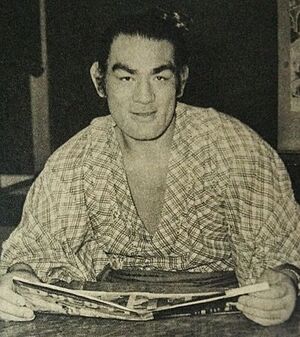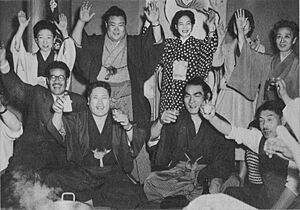Asashio Tarō III facts for kids
Quick facts for kids Asashio Tarō |
|
|---|---|
| 朝潮 太郎 | |

Asashio in 1953
|
|
| Personal information | |
| Born | Fumitoshi Yonekawa November 13, 1929 Tokunoshima, Amami Islands, Japan |
| Died | October 23, 1988 (aged 58) |
| Height | 1.88 m (6 ft 2 in) |
| Weight | 135 kg (298 lb) |
| Career | |
| Stable | Takasago |
| Record | 497-269-101 |
| Debut | October, 1948 |
| Highest rank | Yokozuna (March, 1959) |
| Retired | January, 1962 |
| Elder name | Takasago |
| Championships | 5 (Makuuchi) 1 (Jūryō) |
| Special Prizes | Outstanding Performance (4) |
| Gold Stars | 7 Chiyonoyama (3) Haguroyama Yoshibayama Tochinishiki Kagamisato |
| * Up to date as of June 2020. | |
Asashio Tarō (Japanese: 朝潮 太郎, November 13, 1929 – October 23, 1988) was a famous Japanese professional sumo wrestler. He came from Tokunoshima in the Amami Islands. He became the 46th yokozuna, which is the highest rank in sumo. After he stopped wrestling, he also became a sumo coach and led the Takasago stable.
Asashio's Sumo Journey
Asashio Tarō was born Fumitoshi Yonekawa on Tokunoshima island. In 1948, he traveled to Japan by hiding on a cargo ship. This was because the Amami Islands were controlled by the United States at that time. A relative in Hyogo Prefecture helped him.
He started his professional sumo career in October 1948. At first, he used his birth name. He was listed as being from Kobe until 1953. After the Amami Islands returned to Japan, he was listed as being from Kagoshima Prefecture.
In September 1950, he reached the second-highest sumo division called jūryō. He won the championship in this division with a great record of 14 wins and 1 loss. This success quickly moved him up to the top makuuchi division in January 1951.
In 1952, he chose his wrestling name, or shikona, which was Asashio Tarō. Early in his career, he earned seven kinboshi, also known as gold stars. These are special awards given when a lower-ranked wrestler defeats a yokozuna. He even earned three gold stars in one tournament in January 1955! He beat Yoshibayama, Chiyonoyama, and Tochinishiki in that tournament.

Asashio won five major tournaments in the top division. Most of these wins happened in Osaka. He won the Osaka tournament three years in a row from 1956 to 1958. His first title came when he was a sekiwake (a high rank below ōzeki and yokozuna). He won in a special three-way playoff.
A year later, he was promoted to ōzeki, the second-highest rank, after winning his second championship. In November 1958, he won another tournament in Kyūshū with an impressive 14 wins and 1 loss. After finishing as a runner-up in the next two tournaments, he finally reached the rank of yokozuna in March 1959. He was almost 30 years old at the time.
Being a yokozuna was tough for him because of injuries. He missed several tournaments due to these injuries. He managed to win one more tournament as a yokozuna in March 1961. He retired from sumo in January 1962 at the age of 32.
Asashio was known for his thick chest hair and eyebrows. In 1959, he was featured on the cover of the very first issue of Weekly Shōnen Magazine. He also appeared in the movie The Three Treasures by Hiroshi Inagaki.
Life After Sumo
After retiring, Asashio stayed involved in the sumo world. He became an elder (a sumo elder is a retired wrestler who can stay in the sumo association) and used the name Furiwake. In 1971, he became the head coach, or oyakata, of Takasago stable after the previous stablemaster passed away.
As the Takasago-oyakata, he trained two future ōzeki wrestlers: Asashio Tarō IV and Konishiki. He even thought Konishiki would become a yokozuna before turning 25, but it didn't happen. He also brought in a Samoan wrestler named Nankairyū. However, Nankairyū left the stable in September 1988 after a disagreement. Asashio Tarō passed away from a stroke a few weeks later.
See also
- Glossary of sumo terms
- List of past sumo wrestlers
- List of sumo tournament top division champions
- List of sumo tournament top division runners-up
- List of sumo tournament second division champions
- List of yokozuna

